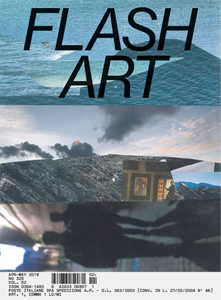This issue of Flash Art dedicates a ten-page dossier to the career of the Damascus-born artist
Simone Fattal. The cover is a previously unpublished project specially conceived by the artist for the magazine. Ala Younis retraces various aspects of Fattal's journey through “the light and the darkness of the self and the other,” while Lina Robertson, with the poem “Alba,” establishes a connection with Fattal's mode of writing
par excellence.
This issue starts with an essay-monologue by Marina Fokidis in which she reflects on how “efforts to forge a counter-discourse to hegemony can themselves become hegemonic.”
Also in this issue,
Peter Halley's schematic abstractions are considered by Elena Sorokina, starting from an analysis of the room as an architectural container “interconnected by invisible channels of communication.” Peter Benson Miller delves into the work of
Yto Barrada, highlighting how the artist unmasks modernist abstractions.
Jacob Korczynski in an interview with Ghislaine Leung talks about the “disruptions” in her exhibitions “which ultimately complicate the institutional infrastructure that enables them.”
This issue also features
Laure Prouvost, who will represent France at the 58th Venice Biennale with a project that posits, as Lillian Davies explains, “an infinity of surprising possibilities” in the notion of the collective; and Shu Lea Cheang, who discusses with Tess Edmonson and Paul B. Preciado her site-specific project 3x3x6—a work that will represent Taiwan at the Venice Biennale as well.
Reviews: Ulrike Ottinger, Elliott Jerome Brown Jr., Elif Saydam, K.r.m. Mooney, Tony Cokes, Mark Rodriguez, Lewis Hammond,
Approaching Abstraction, Kris Lemsalu, Cady Noland,
Isa Genzken,
No Thing: Pope L., Adam Pendleton,
Ellen Gallagher with Edgard Cleijne: Liquid Intelligence,
Decolonizing Appearance, Lauren Luloff, Shoplifter, Naeem Mohaiemen,
Kochi-Muziris Biennale, Ibrahim Mahama,
Mario García Torres.

